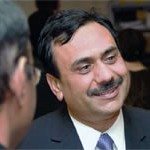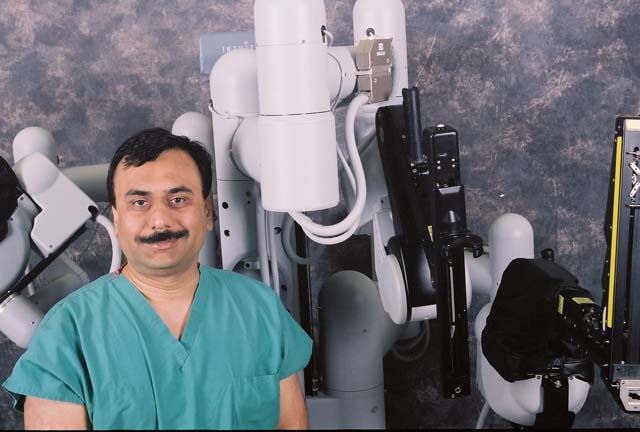Prostate Cancer and the South Asian Male
It’s the hidden killer which is often discovered too late.
The incidence of prostate cancer amongst South Asians in the US is just 4.6 per 100,000 population as compared to 104.3 per 100,000 amongst non-South Asians. Yet when they come in for treatment, 85 percent of them are usually in the late stages, as compared to late stage prostate cancer diagnosis for non-South Asians which is around 15 percent.
Given the sheer numbers of the South Asian population around the world, it is imperative they get checked early. Dr. Ashutosh K. Tewari, an expert on prostate cancer and robotics, discusses the hard facts.

Tewari, a noted expert in the fields of prostate cancer and robotics, has performed over 3500 surgeries. He is a professor of both urology and public health at Weill Cornell Medical College. He also serves as the Director of the Prostate Cancer Institute and the LeFrak Center for Robotic Surgery at NewYork-Presbyterian Hospital/Weill Cornell Medical Center. His prostate cancer program is one of the largest in the world, and he has performed over 2,500 robotic prostatectomies in New York since 2004.
The Indian Genome and Prostate Cancer
Tewari has maintained a strong commitment to India despite being away from the country for 20 years. He has recruited several dozen Indian-born researchers and clinicians for his fellowship program, and over 100 Indian urologists have trained with him in the US. Many of these trainees have gone on to positions in India’s leading institutes such as Medanta’s Medicity, Delhi and Sanjay Gandhi Institute of Medical Sciences in Lucknow. He has been a visiting faculty member to AIIMS, SGIMS, Pune, and Hyderabad where he has performed surgeries. Clinically he has treated hundreds of Indian men with prostate cancer both in India and in the US.
His work with Indian men has led to the discovery that there may be something scientifically different about the Indian genome. Prostate cancer in Indian men is often more aggressive in nature than their Western counterparts. His lab is exploring this hypothesis further and aims to design preventive care and treatment programs specific to the genomic and environmental characteristics of the Indian subcontinent. He has initiated this study in the US, with tissue samples that he has collected from his Indian patients. He is also using his role as Prostate Cancer Health Council for the State of New York to gain support for this study. Tewari is aware of the lack of preventive care measures in the field of prostate cancer in India, and aims to generate prostate cancer awareness in India.
He is building a prostate cancer institute in Pune, India to provide a world-class treatment and diagnostic center for Indian men. It will not only give Indian men access to the scientifically advanced treatments that are used in the western world but will also give them an opportunity to receive care specifically catered to the Indian lifestyle. Tewari’s team will consist of Indian physicians and researchers and he will travel to India himself to train his team and to perform surgery. He will also diagnose patients on a daily basis and plans to use a telepresence portal when he cannot physically be present at the Institute.
Prostate Cancer – Q and A with Dr. Tewari
How common is prostate cancer among South Asian men?
Recently, World health Organization reported the incidence of prostate cancer in the Indian population to be 4.6 per 100,000 population compared to 104.3/100,000 as found in United States. Even though the incidence rates of prostate cancer in Indian populations are much less than that seen in the western world, it is an important cohort of patients due to its sheer size that needs specific studies and subsequent treatment guidelines.
2. Is it something genetic or more common in the Indian-subcontinent?
From our recent studies, we have come to conclusion South Asian men present with more aggressive disease than Caucasians. Other Studies comparing the stage of disease at presentation have shown that the majority of patients (85%) in India presenting for treatment of prostate cancer are detected at late stages (T3 and T4). In contrast, late stage prostate cancer is diagnosed in 15% of the males in the United States that present for treatment. There is published data about the incidence and survival of prostate cancer in this group of population; however, very little has been studied about actual characterization, clinical presentation and genetic behavior of the prostate cancer.
3. What are the warning bells?
Not everyone experiences symptoms of prostate cancer. Many times, signs of prostate cancer are first detected by a doctor during a routine check-up. Some men, however, will experience changes in urinary or sexual function that might indicate the presence of prostate cancer. You should consult with your doctor if you experience any of the symptoms below.
These symptoms include:
- A need to urinate frequently, especially at night
- Difficulty starting urination or holding back urine
- Weak or interrupted flow of urine
- Painful or burning urination
- Difficulty in having an erection
- Painful ejaculation
- Blood in urine or semen
- Frequent pain or stiffness in the lower back, hips, or upper thighs
Because these symptoms can also indicate the presence of other diseases or disorders, such as BPH or prostatitis, men will undergo a thorough work-up to determine the underlying cause. These may include
- Digital Rectal Examination
- PSA testing
- Biopsy
- MRI
4. How can people take charge and control this disease?
The ultimate goal of prostate cancer prevention strategies is to prevent men from developing the disease. Unfortunately, despite significant progress in research over the past 16 years, this goal has not yet been achieved. Both genetic and environmental risk factors for prostate cancer have been identified, but the evidence is not yet strong enough to be helpful to men currently at risk for developing prostate cancer. Early detection and screening has proven to catch prostate cancer early when it is curable and localized.

5. Tell us about the robotics program.
Robotics have ushered in a new era of minimally invasive surgery that has challenged both open and pure laparoscopic surgery. Robotic surgery involves tele-manipulation devices that allow the performance of complex surgical tasks with dexterity and minimal fatigue due to their ergonomic design, expanded degree of movements, tremor filtering, and 3-D stereoscopic visualization. The excellent view of the operative field provided by this master-slave system coupled with the unrestricted ability to execute almost any surgical task has ensured that robotic surgery has become the most popular approach for radical prostatectomy in the United States.
Treatments for prostate cancer have two fundamental competing goals: complete eradication of cancer and minimal morbidity. The term ‘trifecta’ has been coined to illustrate the three goals of cancer control, continence, and coitus (potency).
In order to meet these goals, we use a da Vinci master-slave robotic system and have developed a minimally invasive, robotic-assisted radical prostatectomy (RARP) technique by standardizing a unique sequence of surgical steps, appropriate visual angles using different lenses, optimal retraction strategies, precise suturing steps, and anatomical sparing of the neurovascular structures, as well as by incorporating time-tested open surgical principles. This has been refined further by an understanding of the local anatomy of the nerves and meticulous dissection without the use of thermal energy to control bleeding points. This technique, which we call ART (Advanced Robotic Technique) results in excellent oncological and surgical outcomes, and causes minimal bleeding in expert hands. With this technique, patients and their families have been able to benefit from the quicker convalescence, reduced hospital stays, lesser analgesic requirements, lower blood transfusion rates, and, improved cosmesis compared to the open approach. I was involved in the initial 1000 cases performed at the Vattikuti Institute in Detroit and took over the role as Director of Robotic Center and Prostate Cancer Institute at the New York Presbyterian Hospital.
6. Your advice to South Asian men on how to safeguard themselves?
Why is prostate cancer so common in the Western culture and much less so in Asia and why when Asian men migrate to western countries the risk of prostate cancer increases over time? We believe the major risk factor is diet – foods that produce oxidative damage to DNA. So here are tips on preventing or slowing the onset of the disease.
Eat fewer calories or exercise more so that you maintain a healthy weight.
- Try to keep the amount of fat you get from red meat and dairy products to a minimum.
- Watch your calcium intake. Do not take supplemental doses far above the recommended daily allowance. Some calcium is OK, but avoid taking more than 1,500 mg of calcium a day.
- Eat more fish – evidence from several studies suggest that fish can help protect against prostate cancer because they have “good fat” particularly omega-3 fatty acids. Avoid trans fatty acids (found to margarine).
- Try to incorporate cooked tomatoes that are cooked with olive oil, which has also been shown to be beneficial and cruciferous vegetables (like broccoli and cauliflower) into many of your weekly meals. Soy and green tea are also potential dietary components that may be helpful.
- Avoid smoking for many reasons. Alcohol in moderation, if at all.
- Seek medical treatment for stress, high blood pressure, high cholesterol, and depression. Treating these conditions may save your life and will improve your survivorship with prostate cancer
- What about supplements? Avoid over-supplementation with megavitamins. Too many vitamins, especially folate, may “fuel the cancer”, and while a multivitamin is not likely to be harmful, if you follow a healthy diet with lots of fruits, vegetables, whole grains, fish, and healthy oils you likely do not even need a multivitamin.
- Relax and enjoy life. Reducing stress in the workplace and home will improve your survivorship and lead to a longer, happier life.
- If you are age 50 or over, or have a family history of prostate cancer, you need more than a good diet can guarantee. You should consider a yearly rectal examination and PSA test.

For more about prostate cancer Check this out


1 Comment
Pingback: Dr. Ash Tewari's Prostate Cancer Blog» Blog Archive » Prostate Cancer in South Asian Men